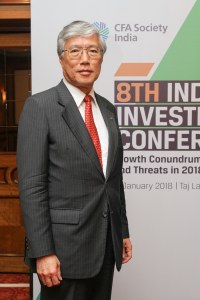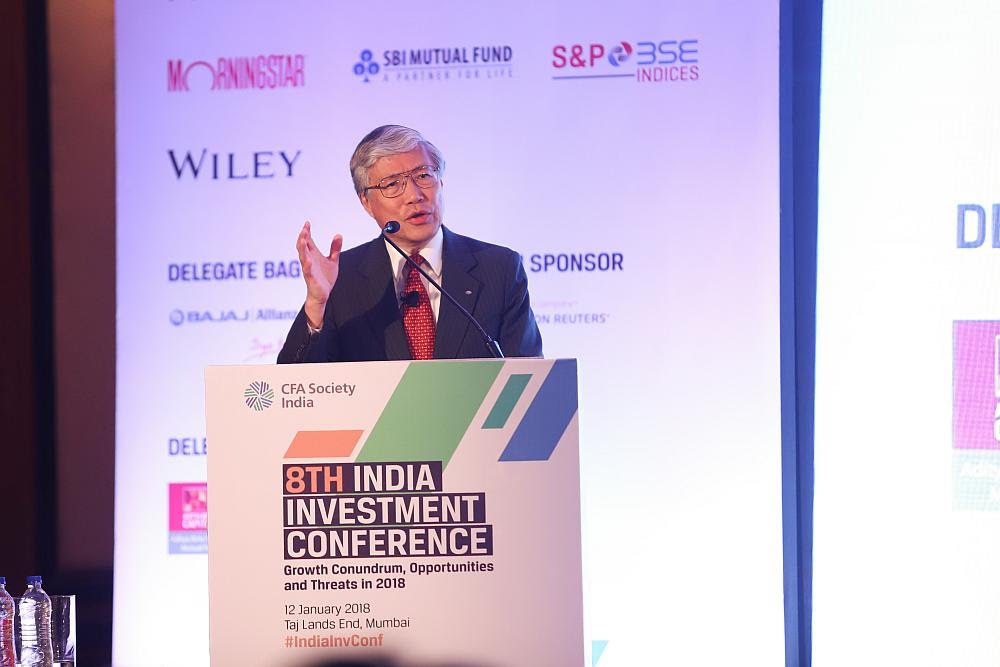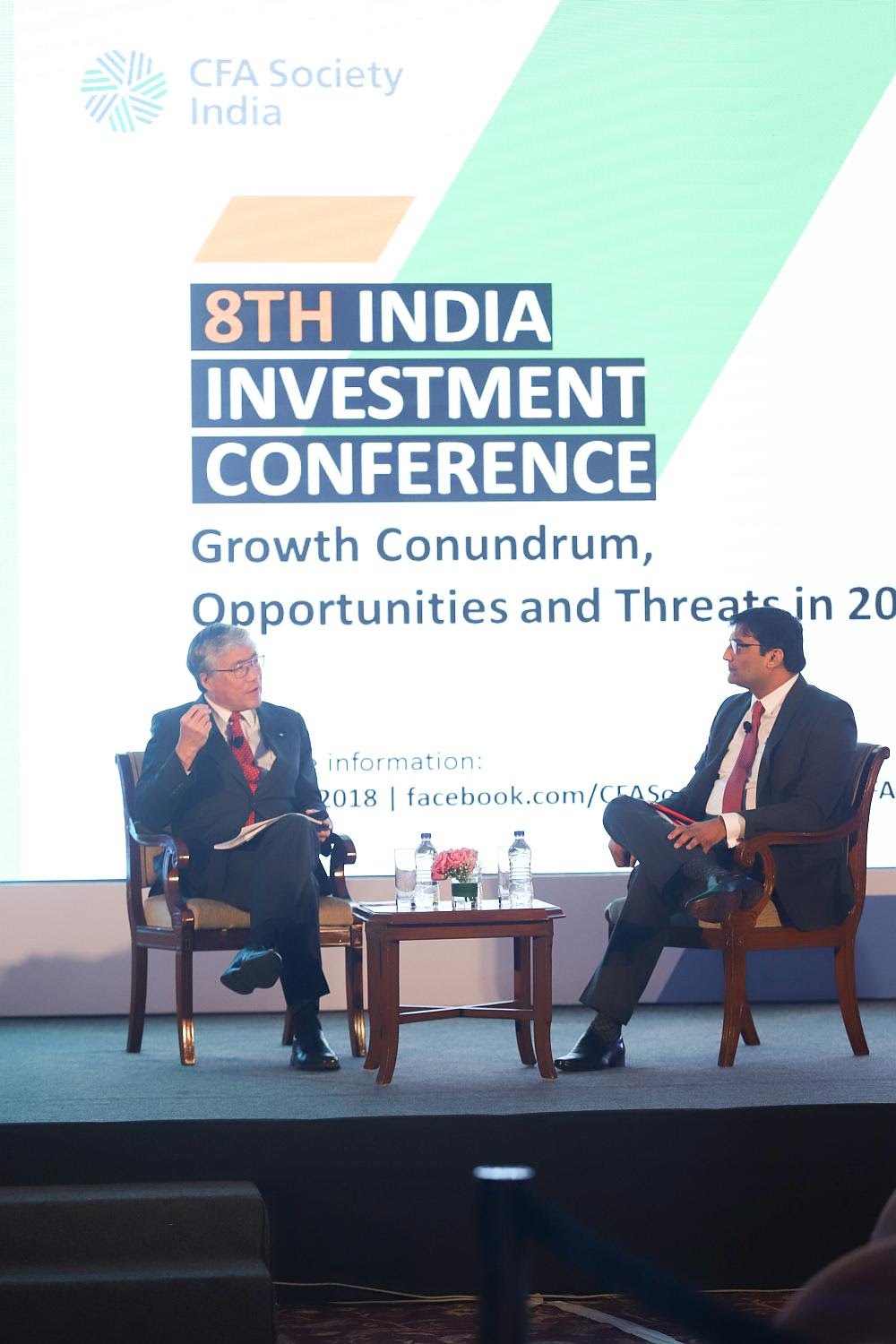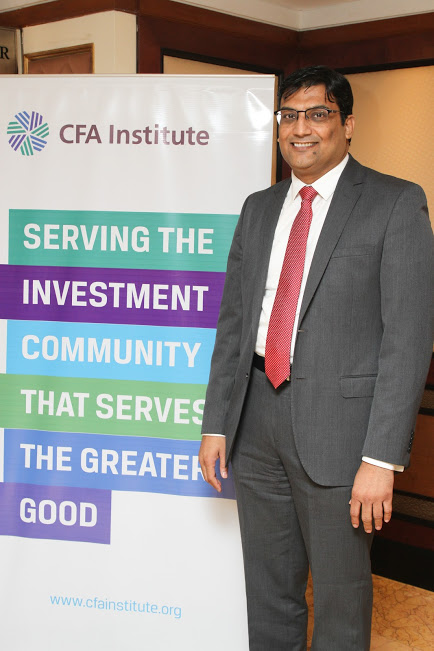- January 16, 2018
- Posted by:
- Category:BLOG, Events, India Investment Conference, Mumbai
 Speaker: Richard Koo, Chief Economist, Nomura Research Institute
Speaker: Richard Koo, Chief Economist, Nomura Research Institute
Moderated by: Navneet Munot, CFA, Director, IAIP and CIO, SBIMF
Contributed by: Ishwar Chidambaram, CFA, CIPM
Mr. Richard Koo began his enthralling presentation with some insights into Donald Trump’s Presidency. He said that Trump won the White House by focusing on “middle USA”- the geographical area between the USA’s Atlantic and Pacific coasts. This region has for long been neglected by successive administrations. Trump merely filled that vacuum. Richard asserted that Trump is having a profound impact on the forex markets, as he is speaking about US trade imbalance. Despite popular opinion to the contrary, Trump’s macroeconomic policies are actually sound, as he is focused on infrastructure spending. The US is beset with problems, as dollars are not flowing from financial sector to the private sector. Nobody is borrowing, even at zero rates! Everyone is simultaneously engaged in repairing their balance sheets, leading to a phenomenon which Richard termed as “Balance Sheet Recession”.
markets, as he is speaking about US trade imbalance. Despite popular opinion to the contrary, Trump’s macroeconomic policies are actually sound, as he is focused on infrastructure spending. The US is beset with problems, as dollars are not flowing from financial sector to the private sector. Nobody is borrowing, even at zero rates! Everyone is simultaneously engaged in repairing their balance sheets, leading to a phenomenon which Richard termed as “Balance Sheet Recession”.
He lamented the fact that most textbooks and theories focus only on the situations wherein borrowers exist in the market- this is the scenario where the private sector is maximizing profits. However, the case where borrowers are absent is largely neglected. This is the situation where private sector is minimizing debts. All advanced economies are currently witnessing this situation, wherein private sector borrowers have vanished post the 2008 financial crisis.
Ideally the Monetary Base, Money Supply and Bank Credit should move together. But in the US today, they have decoupled. Despite the relentless injection of liquidity by the US Federal Reserve, Bank Credit has increased only 30% in past 9 years, which is practically nothing! The situation is worse in Europe, where Credit has increased only 1% over the past 9 years, while in UK it has actually fallen. Similarly, in Japan, Governor Kuroda increased liquidity, but it had zero impact on Bank Credit. At the same time the monetary base has grown by 4.6x, 3.52x and 6.84 in the USA, Europe and UK. In Japan the same has increased 3.43 times between 2013 and 2017. These grim statistics lead to only one inescapable conclusion- namely, there is a big disconnect between Monetary Policy and the Real Economy. This can be seen further in the fact that, theoretically, increased printing of currencies by the developed economies should increase the supply of the currencies leading to a fall in their value; but this did not happen as Credit did not increase.
Alluding to India and China, Richard was relieved that they are not facing Balance Sheet recession. In the case of Japan, however, its nominal and real GDP never fell below the peak of the bubble, as the Japanese Government acted as the borrower and spender of last resort. Hence the Japanese private sector had income to pay off their debts and corporates were able to repair their balance sheets. Hence if the private sector is minimizing debt then the Government has to act as borrower of last resort. But, perhaps ominously for Japan, 27 years after recession the private sector is still not borrowing money. This is because deleveraging is very painful. The USA’s experience is likely to be similar, as nominal GDP fell by 46% in US, whereas Japan’s nominal GDP did not fall post the bubble.
Referring to the absence of borrowers in USA, Richard posited that Return on Capital is higher abroad than at home for US and Japanese companies. This presents a peculiar problem, as modern credit policy only works if there are borrowers. If there are better opportunities abroad, then monetary policy loses its effectiveness.
Next, he presented the three stages of economic development, namely- Stage 1 wherein most workers are in rural areas and wages are flat; Stage 2 where workers are mainly in cities and wages are upward sloping (Golden Era); and Stage 3 which is the pursued World where ROE abroad is greater than ROE at home. All developed countries are at Stage 3 currently. Policies like printing money, etc. are all based on Golden Era rules, and are not applicable to developed economies. Instead Fiscal Policy assumes greater importance in such cases.
Finally, referring to the Fiscal Cliff, Richard said the reason for USA’s relative outperformance is that the Federal Reserve was the only Central Bank that told its Government not to cut the deficit. Still the Fed appears to be behind the curve on asset prices. Its Financial sector is flooded with money (due to Balance Sheet recession) wherein:
- Households stop borrowing
- Companies are deleveraging, and
- Government is printing money
–IC









